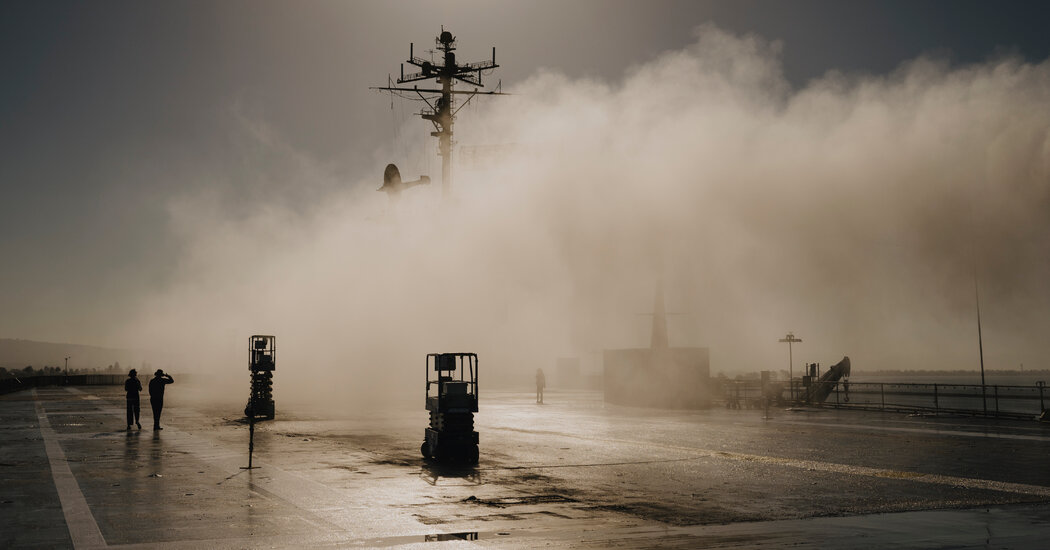A technology that could one day cool the planet cleared a key hurdle on Thursday.
At the beginning of April, scientists from the University of Washington began testing a device that sprays tiny sea-salt particles into the air. The initial tests, held on the deck of a decommissioned aircraft carrier in Alameda, Calif., were simply to see if the machine propelled a mist of suitable size. But, in the future, versions of that device could eventually be used to spray particles into clouds, causing them to reflect more sunlight back into space and to temporarily ease global warming.
Two weeks later, Alameda officials ordered the researchers to stop their experiment, citing possible health and environmental risks. The city said it would commission its own assessment to determine whether the experiment posed any threat.
On Thursday evening, Alameda released its findings: The experiment does not generate “a measurable health risk to the surrounding community” or pose a risk to wildlife, the city said.
“The chemical components of the saltwater solution (which is similar to seawater) being sprayed are naturally occurring in the environment,” the report said. It also noted that seawater “is one of the largest sources of natural aerosols in the atmosphere.”
Alameda city councilors plan to meet on June 4 to consider the report and to decide whether to allow the experiment to resume. Researchers had hoped to test the device in different weather conditions over several months or more.
The report, presented by Alameda’s city manager, recommends that City Council “consider granting” that permission, with additional safeguards in place. The recommended safeguards include setting up air quality monitors at the test site and limiting the hours during which the device can be used.
Officials also recommended that the City Council require the researchers to show in writing that the experiment meets “all local, state and federal regulations,” including written confirmation from the Bay Area Air Quality Management District and the Regional Water Quality Control Board.
A spokeswoman for Alameda, Sarah Henry, said that the officials who had written the report were not authorized to comment on it.
Brightening clouds is one of several ideas to push solar energy back into space, a concept sometimes called solar radiation modification, solar geoengineering or climate intervention.
The idea is built on a scientific concept called the Twomey effect: Large numbers of small droplets reflect more sunlight than small numbers of large droplets do. So spraying vast quantities of minuscule aerosols into the sky, forming many small droplets, could change the reflective properties of clouds.
Compared with other options, such as injecting aerosols into the stratosphere, marine cloud brightening would be localized and use relatively benign sea-salt aerosols in place of other chemicals.
Researchers say that there are potential side effects that still need to be studied, including changing ocean circulation patterns and temperatures that could hurt fisheries.
Environmentalists warn that the technology could thwart the deeper changes required to address climate change. If people believe that global warming can be addressed by artificially cooling the planet, some say, the momentum could slow toward renewable energy, electric vehicles and other changes required to reduce the emissions of planet-warming gases.
The researchers working on marine cloud brightening agree that the technology should not be viewed as a substitute for moving away from fossil fuels. Instead, they say that the research is important in case that transition continues to move slowly and short-term efforts to cool the planet become necessary. In other words, the technology might buy some extra time.
The strong emotions that typically accompany discussion of solar-geoengineering research could be seen in the debate over the experiment in Alameda. When the city said on Facebook that it was halting the experiment, commenters sparred over the decision.
“Leave our skies alone. The natural sunlight is our birthright,” one person wrote. Another commenter said: “They could do that in Washington. No need to do that here.” (The researchers say that the weather conditions in San Francisco Bay make it an ideal spot for the experiment.)
But the announcement also drew comments in support of the experiment. “I’m hopeful that this could be a tool to fight global warming,” one commenter said. “Some extra clouds would be nice,” another wrote.
